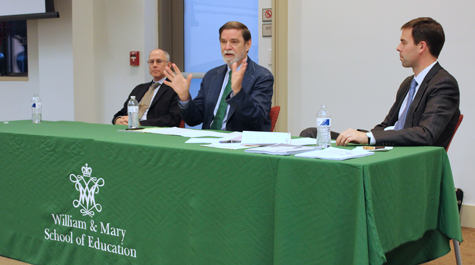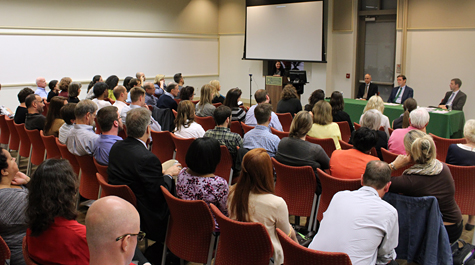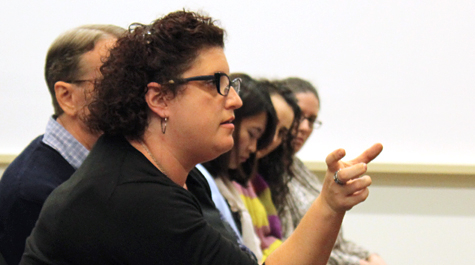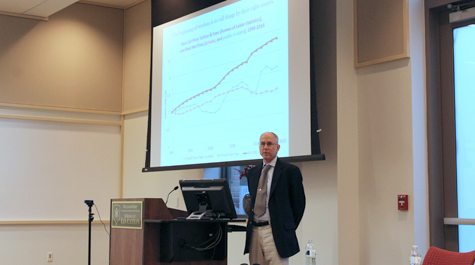Professors see changes, not crises, ahead for higher ed
The future of higher education isn’t as dire as some have made it out to be, according to William & Mary faculty members.
“We think that the future of higher education is going to be full of lots of change, but we don’t think that it’s going to lead to universities being relics,” said Chancellor Professor of Economics Bob Archibald.
The remarks were made during a higher education salon held in W&M’s School of Education Oct. 14. Archibald, Professor of Economics David Feldman and Vice President for University Advancement Matthew T. Lambert ’99 were the featured speakers at the “Financing Universities, the Public Good and the Future of Higher Education” event, where they tackled some of the biggest issues facing higher education today, such as student debt, cost, state support and technology.
Lambert is the author of Privatization and the Public Good: Public Universities in the Balance. Feldman and Archibald are the authors of Why Does College Cost So Much?, and they are currently working on a second book, Turbulent Waters: The Future of America’s Colleges and Universities.
By the numbers
When people talk about the skyrocketing cost of higher education today, they are usually looking at the list price and not the average net price, which is what most students actually pay, said Feldman. However, the numbers reveal that there has been almost no change in the net price of private, four-year colleges over the past 25 years.
“I say that, and people’s mouths drop open,” Feldman said. “All they’re thinking about is that list price.”
Looking at public colleges, the net price has been more volatile due to fluctuations in state funding, but it was still trending in a very similar manner to the net price of private colleges until the financial crisis of the early 2000s significantly affected state budgets, said Feldman. While the average net price has risen at public colleges, the cause is mostly state cutbacks and not bloated staffing or the addition of such apparent luxuries as climbing walls or lazy rivers, he said.
Still, the topic of increased student debt remains a hot-button issue in American society today, and Feldman acknowledged that the numbers do show an increase over the past 15 years.
“But in terms of the value of the education, the increase in debt, although it is worrisome, is actually kind of small for all the language of crisis being attached to it,” he said.
Comparing student debt across different types of institutions, Feldman and Archibald found that more than half of the increase is actually coming from one sector: for-profit colleges.
“If you add up the increase in payments of people from two years, non-selective four years, somewhat-selective four years and at graduate school, which is where big debt happens when you borrow to go to law school, all that debt only equals the extra debt that students are taking on to go to for-profit schools. I didn’t say whether that was good, bad or indifferent – it’s a fact,” he said.
In addition to student debt, concerns about college no longer being a guarantee of financial success are often raised today, Feldman said, adding that it never was and can never be. However, comparing young people between the ages of 25 and 35 who received a postsecondary degree and those who only graduated high school, 80 percent of the college grads made more than median income of high school graduates.
"There’s no evidence that the return to a college degree is declining compared to what it has been,” said Archibald. “In terms of the economic proposition that you face, you have to decide whether spending four years in college will put you into a better position than not. Even if salary hasn’t gone up much, salaries for people with a high school degree have gone down. Economically, the payoff to a degree is strong; people who say otherwise don’t understand the data.”
Threats to higher ed
With all the concerns today about the future of higher education, Archibald said that the title for the new book, Turbulent Waters, seemed apropos. In it, he and Feldman will explore apparent threats to higher education in the categories of internal threats, environmental threats and technological threats.
Internal threats include factors that are driving the costs of higher education up, Archibald said.
“The real discussion is about whether the things that drive the cost of education are inefficiencies, things that slick managers can get rid of, or are there just inherently things about doing education that are going to keep costs rising, and we very much believe the latter position,” he said.
Environmentally, universities and colleges may face financial difficulty as the wealth distribution gap widens, family incomes stagnate and a smaller number of people find themselves among the top economic classes, meaning fewer people will be able to pay the list price for higher education, Archibald said. Technology may also play a role in changing higher education, he said, pointing to the economic advantages of distance and competency-based models of education but acknowledging their limits.
“We think that the people who are touting this don’t really understand all of what makes up a college education at a reasonable college because all of the focus is on providing education,” he said. “None of the focus is on providing other services that can be really important for how a student is able to function.”
State support and the public good
In his research, Lambert talked with more than 150 legislators in Virginia, North Carolina and California to learn more about their thoughts on higher education, including its place among the states’ competing priorities.
“I had one legislator describe institutions as having long arms and short memories,” said Lambert, adding that legislators often feel as though they must choose between funding things like healthcare for the elderly and higher education.
“That’s something we have to keep in mind as universities, that there are many, many competing interests,” he said.
At the same time, Lambert found that legislators were rarely looking at the role of higher education in democracy and the broader good that comes from having an educated society, focusing instead on whether students can get high-paying jobs after graduation.
“I think there is a broad-based feeling that much of what happens in higher education is so far removed from the application that many in the legislature and more broadly want to see that they have a hard time connecting what faculty do inside and outside of the classroom with what they see as good for the state and society,” Lambert said.
Lambert said that public-private partnerships can help universities fulfill their public missions while also giving them the autonomy and flexibility to fund themselves as state support diminishes.
“What we do is important broadly in society, so regardless of which public you’re thinking about, we have to remain focused on those publics and maintaining a public mission for those institutions,” he said.
Although higher education faces a number of challenges ahead, many without easy answers, Feldman, Archibald and Lambert seemed positive about its future – despite ominous predictions by others.
One legislator told Lambert that higher education is the proverbial frog in boiling water, oblivious to how hot the water is getting because of how long it has been in it.
“I personally don’t believe it’s that severe,” said Lambert. “I personally believe the future is very bright.”


















